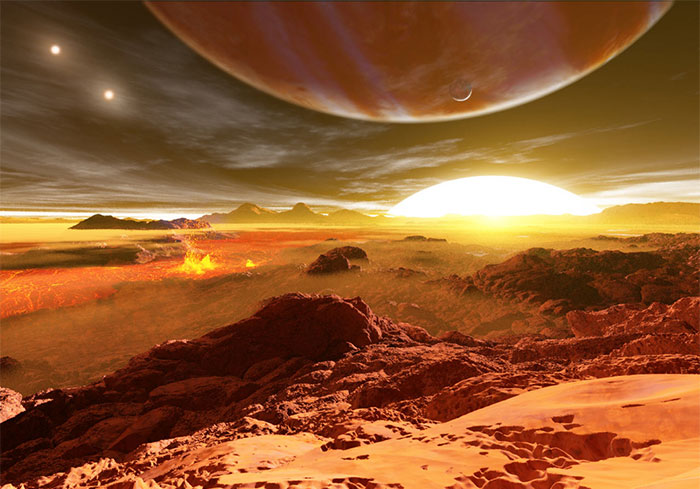New signs of advanced alien life discovered
Bromethane or methyl bromide (CH 3 Br), which coexists with Earth's organisms, is something scientists should be on the lookout for on worlds suspected of harboring extraterrestrial life.
Research led by Dr. Michaela Leung from the University of California at Riverside - USA, NASA's "Alternative Earth" team and the NExSS Virtual Planetary Laboratory confirmed that CH 3 Br will not only represent microorganisms but can also indicate the hiding place of advanced alien life.
These would be large algae, fungi and plants, possibly similar to those present on Earth.

A potentially habitable alien world orbits an M-dwarf star - (Graphic: Ron Miller)
"Methylation is very common on Earth, so we would expect life elsewhere to be able to do it. Most cells have mechanisms to expel toxic substances," Dr. Leung told Sci-News .
CH3Br is created by methylation , when a living organism adds one carbon atom and three hydrogen atoms to an unwanted chemical element, in this case bromine, allowing it to drift safely back into the atmosphere.
So if Bromethane or any methylated compounds are identified in the spectra of exoplanets, that could be where life is hiding.
CH3Br is mentioned because it has an advantage over other methylated gases. It remains in the atmosphere for a shorter time than traditional biomarker gases, suggesting that life on that planet may still be ongoing.
The compound is also more likely to be produced by living organisms than by a natural process like methane, which can be a product of volcanoes or other geological processes.
Additionally, the gas absorbs light near a biologically specific cousin , methyl chloride (CH 3 Cl) , which increases the likelihood of detection. Although methyl bromide is extremely common on Earth, it is not easily detected in our atmosphere because the intensity of the Sun's UV light breaks down atmospheric water molecules into gaseous breakdown products.
However, with an M-dwarf star common in the Milky Way, which is cooler and less radiant, this would be a potential and easy-to-detect biosignature.
Even though many potentially habitable planets have been discovered among the more than 5,000 confirmed exoplanets, Earth's telescopes are still not powerful enough to peer directly at the surface of any world to see if anything is moving on it.
But life can be identified entirely by biological signatures from spectral data of exoplanetary atmospheres, such as oxygen, methane. which are also closely related to life on Earth.
The study was recently published in the scientific journal Astrophysical Journal.
- Hunt for aliens by wavering
- Sometimes we have discovered the trace of aliens already, just do not know what it is
- Stunned with a new announcement about alien life signs
- New direction to search for alien life
- NASA robots continuously catch 'unexpected life signals'
- With this situation, even if we find aliens, we are not sure
- Alien life can be discovered in the next 20 years
- Stunned new alien life exploration tool
- Detecting signs of life on Pluto
- Discovering the 'ghost particle' - A strange form of life outside the universe
- Alien lake more than 1 million km2 wide discovered
- Philae detected the signs of life on comets
 Van Allen's belt and evidence that the Apollo 11 mission to the Moon was myth
Van Allen's belt and evidence that the Apollo 11 mission to the Moon was myth The levels of civilization in the universe (Kardashev scale)
The levels of civilization in the universe (Kardashev scale) Today Mars, the sun and the Earth are aligned
Today Mars, the sun and the Earth are aligned The Amazon owner announced a secret plan to build a space base for thousands of people
The Amazon owner announced a secret plan to build a space base for thousands of people